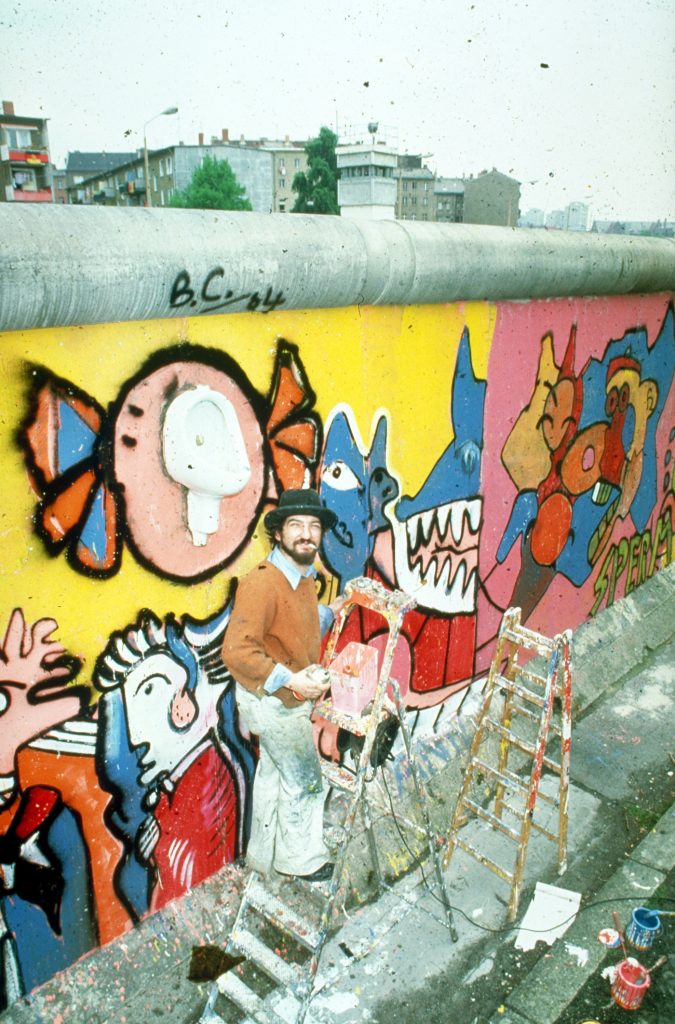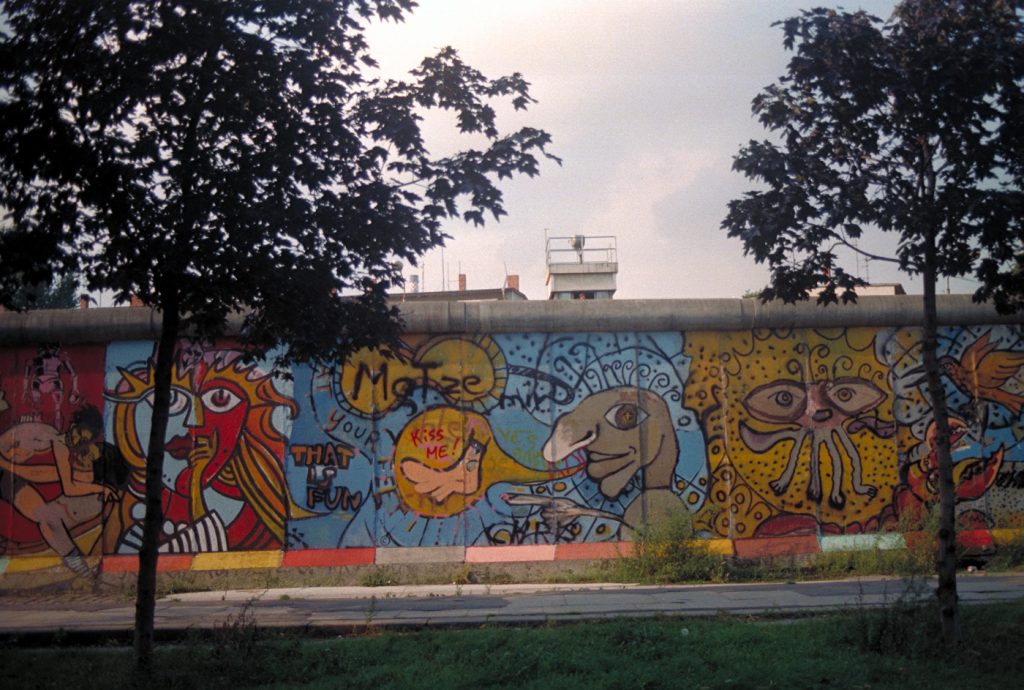Christophe E. Bouchet
28 Feb 1959 to 1 Feb 2021

Christophe-Emmanuel Bouchet, was born on 28 February 1959 in Saint-Aignan sur Cher, (France) and died peacefully in his sleep in his studio in Düsseldorf on 1 February 2021. A very deep friendship united me with him, who accompanied me in my early years in Berlin.
I met Christophe Bouchet in July 1982, a few months after my arrival in West Berlin. He was painting in front of the Kudamm Karree, a shopping passage located along the most prestigious street in West Berlin, the Kurfürstendamm. The intensity and speed with which everything happened in the Berlin scene at the time gave us, two friends who didn’t speak German at all, a feeling of freedom. We simply took that freedom. Of course, we each fought in our own way and at our own pace. One idea followed another… Our paths were not always the same, but we were deeply connected. He painted the perspective of Kurfürstendamm on canvas with the famous broken church in the background, which had been bombed during the Second World War and left as it was, to show the younger generations that war is a terrible thing.
Being hard of hearing, Christophe was very introverted and had few contacts. He could not express himself well, especially in German. His subjects were religious. He had painted the New Testament on heavy wooden panels (150cm x 120cm x 2cm). Very heavy panels. Our relationship was a very discreet friendship. I didn’t talk much and he didn’t listen much. We were not competitors in any sense of the word. Two very different characters who complement each other. Of course, it was also our youth that allowed a lot of tolerance. Neither he nor I were fluent in German. Curiously enough, even that didn’t play an important role. Everything was just the way it was. My respect for him is mutual, I think. He took me to his then lonely and quiet world and I took him to the life I was discovering: Selling small canvases in City centre restaurants such as Foffi, Paris Bar, Ax-Bax, Florian, Théo, etc. It has changed his life and his painting too. Together we were strong. At the same time, he got to know the musicians and the Berlin scene through our new contacts, and the scene got to know us too of course.
From December 1982 we started to see each other every day and to work together. Little by little I decided to do what Christophe and many other young people in West Berlin did: make a living from my art. After losing his flat twice in a few months, I had to urgently find him a room in the house where I lived, the Georg-von-Rauch-Haus youth centre, near the Berlin Wall, at Mariannenplatz. The back of this huge house, which is part of the former Kreuzberg hospital, called Bethanien, was only a few metres from the Wall. We received a room in the basement at the back of the house and converted it into a studio. The door opened directly onto Bethanien Damm, a street with the Berlin Wall in the background.
It was well known that West Berlin was an international village. There were many like-minded people who were nevertheless very different. All of them were, if you asked them: artists. The funny thing is that all these people, almost 40 years later, are still artists. I’m still one too. We immersed ourselves together in the world of the West Berlin intellectual scene. At the same time, I learned from him the technique of art that he showed me along the way. I learned a lot. That’s true. But this mutual encounter did us both good, so that Bouchet began to form his subjects more freely in his paintings and to answer questions, that he didn’t understand, acoustically. He improvised by reading on the lips of questioners.
We didn’t come to West Berlin to paint the Wall, but little by little the idea sprang up. After buying a car, a white Renault 4L with 4 green doors, we collected a lot of things that had remained in the recycling containers along the streets. These containers were mainly around Chamisso Square, in Kreuzberg, almost in front of every house at the time. The facades of the houses in this area were to be completely repainted in preparation for the 750th anniversary of the city in 1987. In order to be quick and to finish as quickly as possible, the painters did not finish the large pots of paint, but rather opened a new pot and threw the almost empty one at the foot of the scaffolding into the containers in front of the house. Christophe was passionate about found materials. He would open the door, jump out of the moving car, and before I even find a place to stop, he had already climbed into a container. So, we soon found ourselves in our studio near the wall, in front of a nice pile of large paint pots more or less full, which gave us a reserve, just in case…
Nobody had told us before that painting the Berlin Wall was a taboo subject inside the German society. Suddenly, around 5.30 in the morning, on a full moonlit night on Monday 16 April 1984, I gathered my courage in both hands and painted the first painting on the Berlin Wall. The painting was done that morning using only sprays and no ladder. It consisted of two dogs sitting and drooling as they looked at a medal hanging in front of them. It was the same motif that had me dismissed from an office in Lyon in August 1980. But the ice was broken, the first gesture was made. In the days that followed, we improved the system and, with two ladders and rollers, we painted 100 metres of wall in a month.
Our atelier was used, before we took it over, as a reserve for various sanitary elements belonging to the youth centre. The question now was: what to do with all these abandoned objects? There were two solutions: either throw them away or do something with them. Following the second solution, we came up with the idea of paying homage to Marcel Duchamp with one of the urinals found in the studio. Duchamp had presented a urinal as a work of art at an exhibition in New York in 1917 and gave it the title: Fontaine. This is the name we have also given to the new urinal, which was hooked at a height of 2.50 metres on the Berlin Wall.
A few days later, on 16 May 1984, at around 6 a.m., four GDR border guards took that artwork along with a pair of shoes nailed to the wall, a washbasin and a framed cellar door. This heavy door, which was supposed to symbolise the Gate of Paradise, was not yet fully fixed to the wall. The sound of the electric drill and the lights of the television crew, filming the scene, aroused the curiosity of the guards behind the wall. The Gate of Paradise disappeared, never to return. It was lifted with its frame 3.60 metres high over the wall by the border guards who pushed it with great difficulty to the other side. It should be explained that the Wall was not quite the border between East and West. It had been erected by the GDR about 5 metres behind the demarcation line in order to be able to control both sides. It was therefore dangerous to paint the Wall. You always had to look around you. Despite the danger, Christophe drilled a hole at eye level through the wall with an electric drill during our artistic action, so that it was possible to see the other side. A first in the history of the wall. But all these actions cost us dearly. We have been suffering the consequences for years.
On 19 November 1984, we wanted to take the train from West Berlin to Malmö (Sweden). At the border crossing at Friedrichstrasse in Berlin we were controlled by the GDR train police. In his suitcase Christophe had a French magazine “Actuel” in which several photos of the dismantling of the Gate of Paradise had been published during the summer. When they saw the photos, the border guards said: “Oh dear, our soldiers!”. They also found letters from the Checkpoint Charlie Museum. Christophe was immediately declared “persona non grata in the GDR” and had to get off the train. After a one-hour interrogation he was told: “The next time you enter the GDR again, you will get two years in prison”. Christophe was then allowed to take the metro back to West Berlin. After being stamped “transit prohibited” in the GDR control system, Christophe Bouchet was never again allowed to travel by train or car to or from West Berlin. For my part, I used transit routes in or out of Berlin only very rarely and never went to visit East Berlin.
In that sense, Christophe! I’m glad we met in this life and I wish nothing more than for you to rest in peace, wherever you are.
– Thierry Noir


